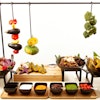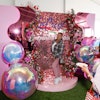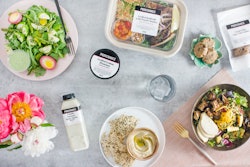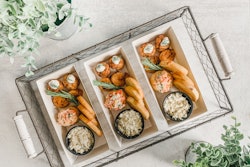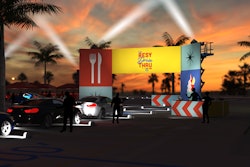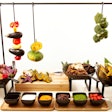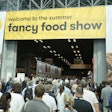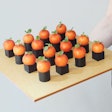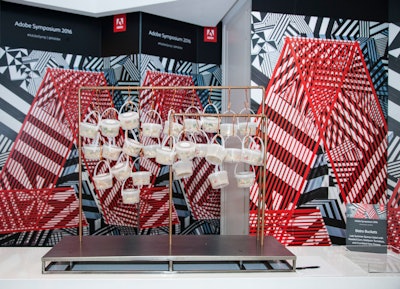
As states across the U.S. begin to slowly reopen, industry pros have begun brainstorming how in-person events will be able to adhere to potential safety guidelines regarding COVID-19. And catering and food service is perhaps the biggest issue they’ve been chewing on.
With restaurants dotted around the globe, the team at Wolfgang Puck has been contemplating safety guidelines since the start of the pandemic, and is currently prepping for the reopening of some U.S. locations including the Wolfgang Puck Bar and Grill at Disney Springs near Orlando. For the next phase—live events—Mary Cline, East Coast regional director of catering sales, for Wolfgang Puck Catering (WPC), said that the company is following local and state government guidelines for restaurant reopenings, along with recommendations by the Centers for Disease Control, to help set the protocol.
Here, Cline and other event experts share their thoughts on what catering will look (and taste) like when live, in-person events are up and running again.
Rethinking food service
Will shared food service stations, such as buffets, survive the coronavirus? That’s still up for debate, according to our experts.
Katie Fleury, director of sales for Washington, D.C.-based Ridgewells Catering, says that “we do think that, for the most part, these are gone for good—at least in the traditional ways in which we’ve known them. We think we’ll see those mostly convert to small-plate, chef-attended stations. These are a great solution, and may actually allow for some really fun and innovative new catering ideas and trends.”
Jason Berkowitz, founder of Arrow Up, a hospitality consulting company currently helping restaurants reopen safely, echoes Fleury’s idea, saying that caterers will need to reinvent the way a buffet line works and operate more like chef-serving stations as opposed to guests helping themselves, or ready-made plates will be up for grabs along with individually wrapped silverware.
“I wouldn’t pull the plug on buffets just yet—or at least not fully,” says Doug Quattrini, current national president of the National Association for Catering & Events and an off-premise caterer for Sensational Host in Maple Shade, New Jersey. “They will definitely look different in the short term, with additional staff serving the food from chafing dishes and platters, and probably will require some type of shielding, but buffet-style service, in general, is too popular with too many to totally disappear. As with everything else, it will be about providing a visible level of safeguards so that our clients feel comfortable.”
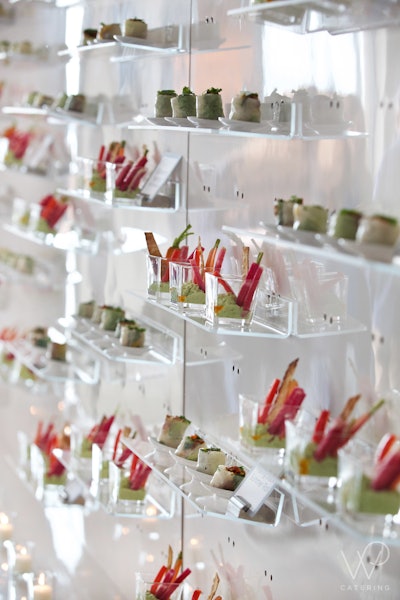 A few years ago, Wolfgang Puck Catering introduced its “vertical buffet.” Cline said that “this is an example of how we can reimagine buffets in this post-COVID event space.”Photo: Courtesy of Wolfgang Puck Catering
A few years ago, Wolfgang Puck Catering introduced its “vertical buffet.” Cline said that “this is an example of how we can reimagine buffets in this post-COVID event space.”Photo: Courtesy of Wolfgang Puck Catering
As for other creative catering options, Abby Borden, a Los Angeles-based event consultant and owner of Table Set Go, looks to her heritage. “Bento boxes would offer a fully curated meal for each guest that is appetizing for both the eyes and stomach. ... Growing up in Japan, I enjoyed quite a few of these convenient meal boxes in the school lunchroom and even at baseball games.”
Sarah Banasiak, The Revel Group’s chief creative officer, agrees with this concept, saying passed bites could be served in a fun enclosed container. “Think custom branded to-go boxes or retro takes on branded hamburger boxes or mini pizzas in their own mini pizza boxes.” She also suggests passing hors d'oeuvres on large boards such as surfboards and pizza peels “so you don't come face-to-face with someone.”
Borden also says she thinks more food trucks will be pulling up to events. “This protects both the kitchen, the staff, and the guests from cross-contamination.”
Maintaining social distancing
In order to maintain social distancing guidelines, which are unlikely to change anytime soon, in-person events will probably consist of smaller groups in larger venues to accommodate that six-foot radius.
“In the past, clients have looked toward right-sized venues,” Banasiak says. “In the future, we will see people likely looking for venues that offer a little more elbow room and offer the opportunity for space-planning and that allow attendees their own space.”
Cline agrees, saying that “in the first few months of reopening, all types of events will require more spacing. Seated events will likely be held to the same type of standards as the currently reopened restaurants, with a maximum of six guests per table and more than twice the distance between tables than before.”
Also, she adds that bars and attended food stations will need additional space to allow attendants to appropriately distance themselves from one another and from guests, along with space for queuing up, with guests being invited up to the station—much like the one-in, one-out policy to which some stores adhere.
“Guest count restrictions and spacing within venues, to me, is the most challenging topic,” Quattrini says. “Unfortunately, I think we’ll be seeing smaller events at least for the foreseeable future, and floor plans will have to allow for some additional room between guests.”
Borden predicts that seated dinners may be converted to cabaret-type setups with intimate tables of two. “Guests won’t have to say ‘excuse me’ while squeezing in between chairs,” she muses. Plus, for seated dinners, she thinks plate covers and cloches might make a comeback in order to protect the food from the kitchen to the dining room.
Cline added that outdoor events may also become a popular choice, because in larger open spaces such as drive-in movie theaters “individuals can easily socially distance and feel less restricted.”
Cleaning the venues
Cline says that the team at Wolfgang Puck Catering is working with its venue partners to assure guest areas—including tables, chairs, communal surfaces, restrooms, and non-automatic opening and closing doors—are regularly cleaned and sanitized.
“Another part of this equation to consider is that we’ll likely need more staff at each event to help with sanitizing and serving,” Quattrini says, “and they are included in the total count of people at the event, so that will lead to some interesting conversations with our clients.”
Keeping staff and guests safe
Cline predicts that WPC's front-of-house, guest-facing service team members will wear black cloth personal protective equipment (PPE) and black nitrile gloves that are changed frequently. Plus, she said there will be even more stringent rules on hand-washing, and staff will be socially distanced from each other and from guests, as appropriate, at all limited-contact points of service.
This would also apply to the back-of-house (which is not ever known for being a “socially distant” workspace), where staff will be appropriately distanced from one another and wearing disposable PPE. Several of the event pros also mentioned the need for employee temperature checks.
Berkowitz said that, when it comes to training staff on new safety measures, “the key is to ensure they understand the science of the virus and how it's transmitted,” which is why his team provides a thorough overview of the virus during training. “Staying safe comes down to understanding the why and therefore making sure you're answering the how.”
Fleury predicts “we’re going to see a new and much more robust check-in process [for guests] at events, which will definitely include sanitizing stations and perhaps even temperature checks. Those types of things may take some getting used to for guests, but hopefully, the end result is a safer environment.”
Berkowitz adds that event planners will need to post a “safety greeter” at the door. “This is separate from a typical host position,” he explains. “The safety greeter will be responsible for communicating the new experience to the guest including any added safety protocols.” In addition to taking the guests’ temperatures, the greeter would collect the guest’s contact info in case they need to follow up to let them know if they were potentially exposed to COVID-19 while in the space.
While these extra steps may seem like a logistical nightmare, some event planners see it as an opportunity. “I think event teams are going to get creative,” Borden says, by using “black or colored gloves and masks to match the theme of the evening so the guest experience doesn’t feel overly sanitized.”
Banasiak suggests creating custom face masks that are printed with the name and description of the menu item being served. She also says protective acrylic paneling could double as decor, or could feature branding and creative menu displays.


